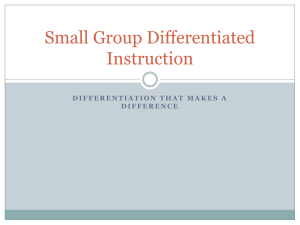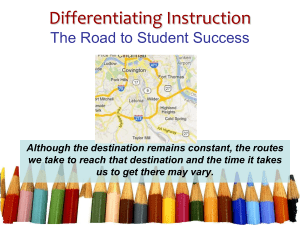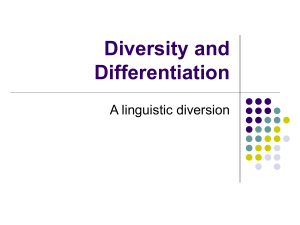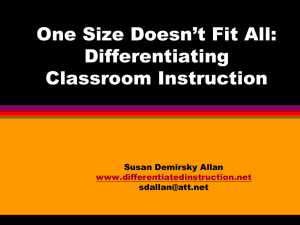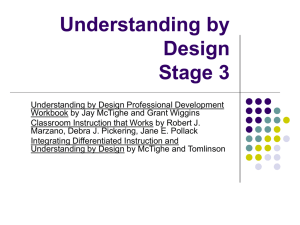Differentiation in the GNETS Classroom
advertisement
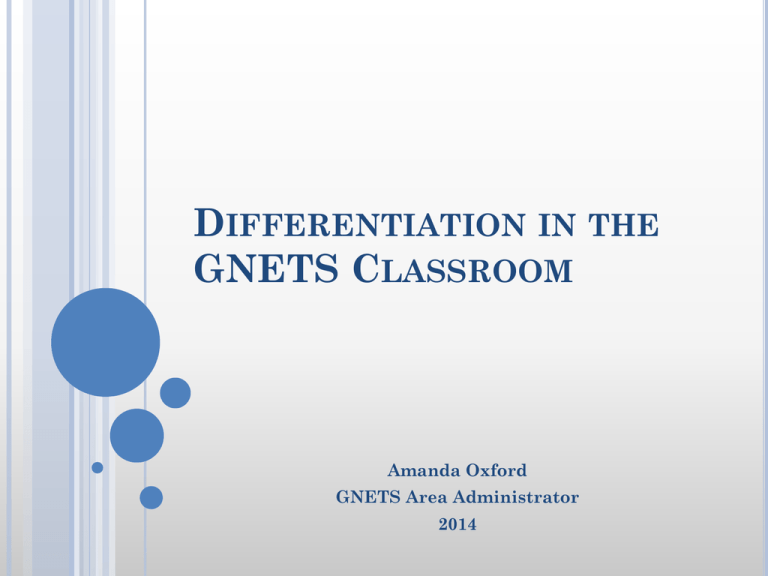
DIFFERENTIATION IN THE GNETS CLASSROOM Amanda Oxford GNETS Area Administrator 2014 “When a teacher tries to teach something to the entire class at the same time, chances are, one-third of the kids already know it; one-third will get it; and the remaining third won’t. So two-thirds of the children are wasting their time.” ~Lilian Katz (teacher educator) WHAT IS DIFFERENTIATION??? Differentiation Scaffolding Modifies content, process, product and learning environment Breaking up a learning experience, concept or skill into discrete parts, then giving students the assistance needed to learn the part. Differentiation and Scaffolding Moving student learning and understanding from where it is to where it should be Blended in a classroom to the point that the two are indistinguishable Both essential in a self-contained setting MISCONCEPTIONS OF DIFFERENTIATION Differentiated Instruction is not a new idea. Differentiated Instruction is not the same as individualized instruction. Differentiated Instruction is not just small group work for students. Differentiated Instruction is not just letting students do what is comfortable to them MISCONCEPTIONS OF DIFFERENTIATION Differentiated Instruction is not just varying your own teaching style. Differentiated Instruction means that teachers also recognize that students need more than one way to experience, practice, and produce. Differentiated Instruction is PROACTIVE rather than reactive. • ~Dr. Johnell Bentz TRADITIONAL VS. DIFFERENTIATED Student differences ignored or acted upon when problematic Assessment only at the end of learning to see “who got it” One definition of excellence exists (100 percent achievement, on objectives tested once) Student interest infrequently tapped Whole-class instruction dominates Student differences studied as a basis for planning Assessment on-going and diagnostic to be responsive to learning needs Excellence defined in large measure by individual growth for a starting point Students frequently make interest-based learning choices Many instructional arrangements (groupings, partner work, centers) ~teachingasleadership.org TRADITIONAL VS. Coverage of texts and curriculum drives instruction Single option assignments DIFFERENTIATED Curriculum/standards still drives instruction Multi-option assignments Multiple materials provided (visuals, manipulatives) A single text prevails Time is relatively inflexible Time is flexible, based on student need Students assessed in one way Students assessed in multiple ways ~teachingasleadership.org DIFFERENTIATE CONTENT Presenting material to students should always involve the teacher and one or more of the following: Textbooks Speakers Fieldtrips Videos Demonstrations Lectures Internet sources Paper resources (newspaper, magazines, books) Lowered /advanced level materials Power point Real world materials/examples Take the time to be thorough! DIFFERENTIATE PROCESS Don’t skip this step! Teacher led, Collaborate as a class, Collaborate in pairs, Homogenous or hetergenous ability groups, Independent work Worksheets (boring) Graphic organizers (training wheels of learning) Discussion Jigsaw, think/pair/share, turn and talk Work at the board Manipulatives Guided practice Present a mystery or problem scenario Vocabulary activities Summarizing strategies SCAFFOLDING IS PART OF THE PROCESS Provides a safety net for students Happens before and during teaching Breaks learning into chunks, then provides structure or a tool with each chunk Activating and previewing strategies Investigate prior knowledge, making predictions, piquing interest, allow time to share personal experiences Show and tell (show sample product, discuss rubric or criteria, what steps do they follow) Think aloud – as you teach model thought processes Quality Questioning - Pause, Ask, Pause, Review Using chants, mnemonics, visual or verbal cues/reminders DIFFERENTIATE PRODUCT GNETS students can do all the things other student do, given time, a sample, and support! Create a poster Create a Powerpoint Design an article www.readwritethink.org student interactives Worksheets , tests, quizzes(yawn) Give a presentation (2 minute talk or more) Build a model Menus of choices Teach another student Debate Write a song, act it out, make a video Publish DIFFERENTIATION/SCAFFOLDING EXAMPLES Elementary ELACC1RL9: Compare and contrast the adventures and experiences of characters in stories Content: two texts, have various reading levels available (movies a nice extra) Process: preview text by looking at cover or abstract then brainstorm predictions and discuss personal knowledge jigsaw to teach key vocabulary, read through texts with graphic organizer, guided group discussion of main character traits and experiences, group teacher led task to create life size character maps Product: compare/contrast report (essay, presentation, poster, chart) DIFFERENTIATION/SCAFFOLDING EXAMPLES Elementary MCC2.NBT.3: Read and write numbers to 1000 using base-ten numerals, number names, and expanded form Pre-assess to determine prior knowledge Does student understand base ten blocks? Can they identify number names? Are they familiar with expanded form? The standard itself is differentiated because you are looking at a variety of methods to identify numbers. Design activities to teach skills needed for each element of the standard incorporate teacher led practice, manipulatives, center activities, individual practice Assess- worksheet/quiz/test, one on one manipulative assessment with blocks, words on cards, and expanded form numbers/symbols on cards DIFFERENTIATION/SCAFFOLDING EXAMPLES Secondary L9-10WHST9: Draw evidence from informational texts to support analysis, reflection, and research. Content: Persimmon seeds, Can they predict the weather? Process: Class discussion with graphic organizer, Brainstorm as a class ways to complete project, some students may be required to seek out their own sources, teacher may provide resources to others, group students cooperatively to investigate Product: slice and create display for given persimmon seeds, share results of research orally or in writing DIFFERENTIATION/SCAFFOLDING EXAMPLES Secondary L9-10WHST1e: Provide a concluding statement or section that follows from or supports the argument presented Content: Smart Snacks in Schools , Yay or Nay? Process: provide resources at varied reading levels and allow students to seek resources, teacher assigned pairs or groups, provide organizer to list key points, provide essay template, allow writing, typing, talk to text on tablet Product: students composes a three paragraph essay for or against Smart Snacks program, present to the class, closing discussion of key points different students raise DIFFERENTIATION PRO’S AND CON’S Pros It is just more fun!!! Research shows it works for gifted as well as students with more severe disabilities Allows students to take responsibility for their own learning Students are more engaged resulting in fewer discipline issues Cons Requires more time put into planning and preparation Limited professional development “There is no one right way to create an effectively differentiated classroom; teachers craft responsive learning places in ways that are a good match for their teaching styles, as well as for their learners needs.” ~Carol Tomlinson DIFFERENTIATING IN GNETS So many grades, so many standards!! Direct instruction programs should be a portion of what you do Units are helpful Developmental Therapy objective Rating Form (DTORF) This fall it was reported that the majority of GNETS students in GA regardless of age were stage 3 students DTORF STAGE 3 Technically should be mastered by age 9 Involves skills for successful group participation Central Concern: Looking good to others Motivating value: Recognition by others, fairness Developmental anxiety: Guilt over failure to meet expectations of others Approach to problems: Self-protective; justify actions; blame others Teacher Role: Be the group leader, benign sheriff and motivator ~Teaching Responsible Behavior, 2007 DTORF STAGE 3 Guidelines for Teaching: Lessons designed so all students participate and feel success Plan activities with short waits and turn taking Establish a few basic rules stated consistently and apply to all Select materials same age peers are using and redesign them as needed to guarantee individual participation and success Emphasize the benefits of group participation ~Teaching Responsible Behavior, 2007 DTORF STAGE 3 TEACHING GUIDELINES CONT: Provide simple instructions and brief demonstrations so students have models to imitate successfully Select content with characters students can relate to emotionally, stories where good triumphs over evil Encourage group discussions about topics that students share as a common interest or experience Redesign games so that teams win rather than individuals Be flexible, improvise, and redesign a lesson when student responses indicate that it is not sufficiently motivating or is too difficult to ensure success Success!! ~Teaching Responsible Behavior, 2007 PROACTIVE = SMOOTH TRANSITIONS A time when many behaviors occur especially when transitioning from lesson to break and break to lesson. Visual cues for boundaries is helpful Timers Verbal prompts before, during, and after The main rule about break time is that we don’t talk about break time…..(applies to recess and lunch as well) When it is time to get back to work review goals and daily sheets SMOOTH TRANSITIONS PBIS can help Posted behavioral expectations Explicitly teaching and practicing transitions Reinforce and reward!! Activating strategies Hook interest and get brains engaged in what is coming next Max Thompson strategies: KWL, word splash, word maps Personal story, visual aide, brainstorming Should be fun and require interaction Can also include reviewing previously taught material in a fun way SMOOTH TRANSITIONS Good closing steps: Break time should never begin at random times as students finish their work, you are setting up slow workers to fail!! Have a predetermined plan for those who finish early, then better differentiate for them the next time Find a stopping point and come together Review academic and behavior positives Allow time to share Touch on the next activity after break Discuss plans for break time and verify Release and start getting set up for the next lesson PROACTIVE = STRUCTURING THE UNSTRUCTURED Centers Technology a necessary evil Tricks for controlling access Set part of schedule and class management system Avoid using as a distraction Family time for education and break time Set part of schedule Meals Break time Scheduling Elementary, middle High school PROACTIVE = ANTECEDENT MODIFICATION Good classroom management in GNETS requires the use antecedent modifications, scaffolding, and differentiation daily. Types of Antecedent Modifications: Environmental Social Supports Task Oriented Teacher Behavior ENVIRONMENTAL MODIFICATIONS Lighting- dim/bright, overhead/lamps, natural, filters Sounds- door open/shut, background music, white noise, headphones Alignment- chair height, slant boards Zoning- seating, specific areas with specific purpose (desks/board, floor space, table, computer area, project area), location of staff Provide tools- visual cues for rules/steps/boundaries, timers visual/auditory, fidgets, soothing space SOCIAL MODIFICATIONS What proactive strategies can you use to help students be socially appropriate in class, with peers, and adults? Circle time/morning meeting or check in Explicit social skills instruction, Role play Visual cues/reminders Behavior specific praise Behavioral momentum Pair with a role model Self-monitoring check list and self-evaluation Set up volunteer/positive relationship opportunities Practice specific skills and then test run TASK MODIFICATIONS High interest or preferred materials Incorporate choices Writing modifications Manipulatives, calculator Break task down into portions Shorten length or reduce complexity of task Schedule work/break times Extended time, multiple attempts Provide a completion schedule or map for difficult tasks Alternate task or lowered/advanced level Always be willing to negotiate!! What is most important? TEACHER BEHAVIOR MODIFICATIONS Proximity Verbal cues for upcoming activities, reminders, and praise Incentive plans/individual behavior contracts Allow students time as soon as frustration is detected Be knowledgeable in coping strategies, offer and guide students in using them All adults in room engaged Reduce down time Incorporate sensory activities for all “Teachers discover that they need to develop and maintain personal relationships with the students they teach -- because for most students, meaningful interaction with a teacher is a precursor to academic learning.” ~Huberman INCORPORATING SOCIAL THEMES A key way to differentiate in GNETS! Develop social knowledge Develop understanding emotional state Traditional Approach- a scheduled period each day for social skills instruction Integrated Approach create a classroom community social thinking integrated into daily instruction social activities part of differentiated instruction content, process, and product! SOCIAL SKILLS TOOLS FOR TEACHERS Key Social Thinking Skills Social Perception Noticing social cues… Paying attention to what’s happening Interpretation of social cues…Understanding what’s happening Social Problem Solving Goal consideration…What do I want to happen? Strategy Generation…What could I do? Strategy Evaluation & Selection…What would happen if I tried? Review Outcomes …Did it work? ~M.E. Brady et al. www.csde.umb.edu/tools INCORPORATING SOCIAL THEMES Easiest to accomplish in literature and social studies Both allow for social segues Help students identify and describe social problems Provide students with the opportunity to experience empathy Practice identifying goals of others, the obstacles they face, and the varied ways they respond to obstacles Provide practice with social problem solving Opportunity to consider consequences of social situations Practice noticing and thinking about details that cue reader to what a character/historical figure is thinking and feeling ~M.E. Brady et al, www.csde.umb.edu/tools GNETS YOU GET OUT WHAT YOU PUT IN Differentiation Being Proactive Transitions Antecedent Modification Incorporating Social Themes


